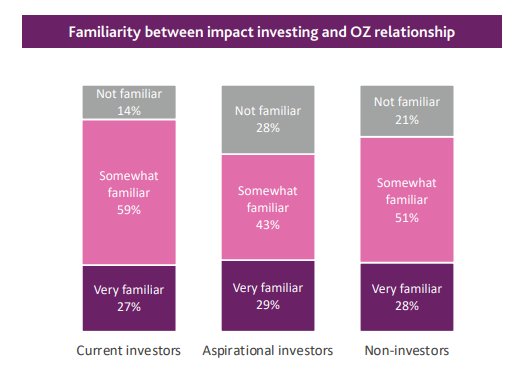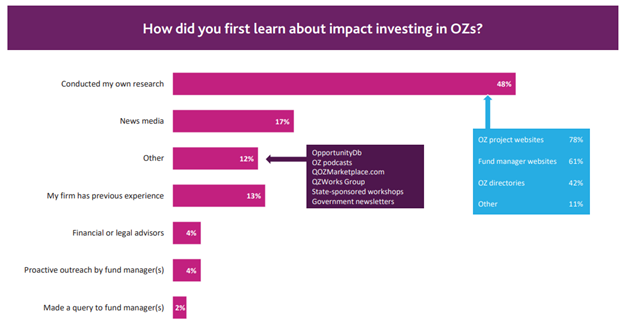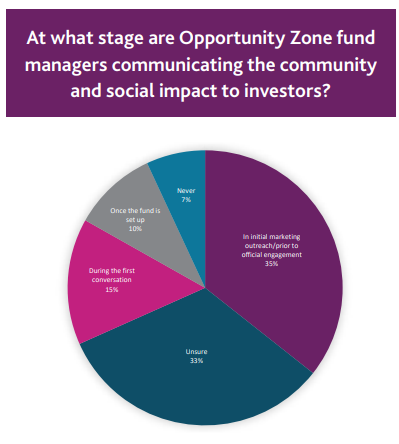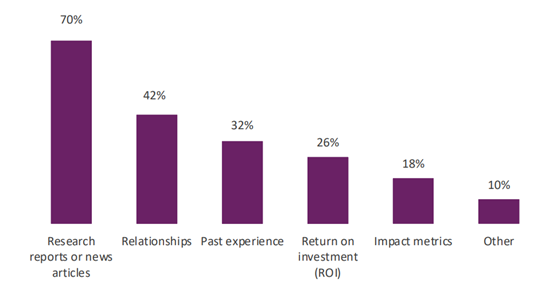When survey respondents were asked about what most influenced their perception of OZs, 70% said “Research reports or news articles,” putting it overwhelmingly in the top spot. If potential investors are reading news stories about OZ as a tax scheme for the rich, they may never listen to a fund manager explaining how Opportunity Zones really work.
“My guess is that this is an issue of branding,” said Richard L. Shamos, Counsel, Nixon Peabody LLP. The panelists largely agreed that there was a legislative intent to help communities, and the initiative was meant to do good, but unfortunately the tax benefits have gotten more attention. So how can the industry combat this misconception?
One way to do so is to highlight success stories. As the survey report explains, “A 2020 report by the White House Council of Economic Advisors showed that OZ investments nationwide are on track to decrease the poverty rate by 11 percent and have created at least 500,000 new jobs. And though investments so far have occurred in only about 1,300 of over 8,700 OZ census tracts, this is much greater than some long-established incentives, like the New Markets Tax Credit program, which supported investment in only 400 during the same period.
“In other words, while the OZ program may not be perfect, it’s doing a lot of good in some of our hardest-hit communities. Fund managers and industry groups should continue to highlight these success stories.”
What the survey has taught us is that many people don’t realize OZ investments are impact investments, and have only been told about the tax benefits. That means there’s an opportunity, if the full benefits of OZ are communicated to them, to attract impact-minded investors and grow the industry.
Making OZ More Attractive to Impact Investors Through Impact Reporting
When the survey was conducted, respondents were given the chance to write in answers to the question of how to make OZ more valuable to impact investors. See if you notice a pattern here:
- “Awareness that there is such a program.”
- “Better reporting”
- “Better understanding of the purpose”
- “Clarity”
- “Better measurement and metrics across the whole program, not all OZ developers are reporting on impact”
- “Clear and improved guidelines on job creation, social impact measure required under OZ program”
- “Clearer metrics on the actual impact that is occurring”
- “Impact reporting”
- “Metrics based on a standardized reporting scheme”
- “More data”
- “More positive stories about impact of OZ on operating businesses”
- “More transparency on individual projects and better visibility”
- “Press coverage in national media”
- “Required impact reporting”
It seems pretty clear that OZ stakeholders want accurate measurement of impact. As the report states, “This is aligned with the findings that investors – especially aspirational ones – are compelled to invest in OZs in large part due to their impact on communities.”
There have been efforts to pass legislation that would require reporting on impact. This could help change the conversation around Opportunity Zones by drawing attention to proven success stories and demonstrate the impact OZ investments are having.
At the webinar, John Sciarretti of Novogradac & Company, LLP, stated his belief that by implementing impact reporting at the Congressional level, investors will be more likely to want to participate.
“I think that transparency will double interest in the program,” he said, adding that this will be especially true for institutional investors who have high standards for data and reports.
Shay Hawkins, Chairman and CEO, Opportunity Funds Association, agreed: “Until we can get clear transparency and reporting and impact requirements in place legislatively, we in the industry have to help folks make that connection.”
JTC has been a leader in Opportunity Zones fund administration since the program’s inception. Our award-winning eSTAC technology platform provides real-time impact reporting along with 24/7 access to key documents, and we’ve pioneered methods for measuring and reporting on social impact. While we wait to see how successful legislative efforts will be, JTC is helping our clients stand out from the pack when it comes to impact reporting.
Other topics were covered at the webinar, including missed opportunities for private equity firms to invest in operating businesses in OZs and why impact reporting requirements were missing from the original bill. Watch the full webinar to hear from industry experts about the current state of OZ and read the full survey report online.
Watch the full webinar recording here: “Getting Impact Right: A New Strategy For Opportunity Zones.”




